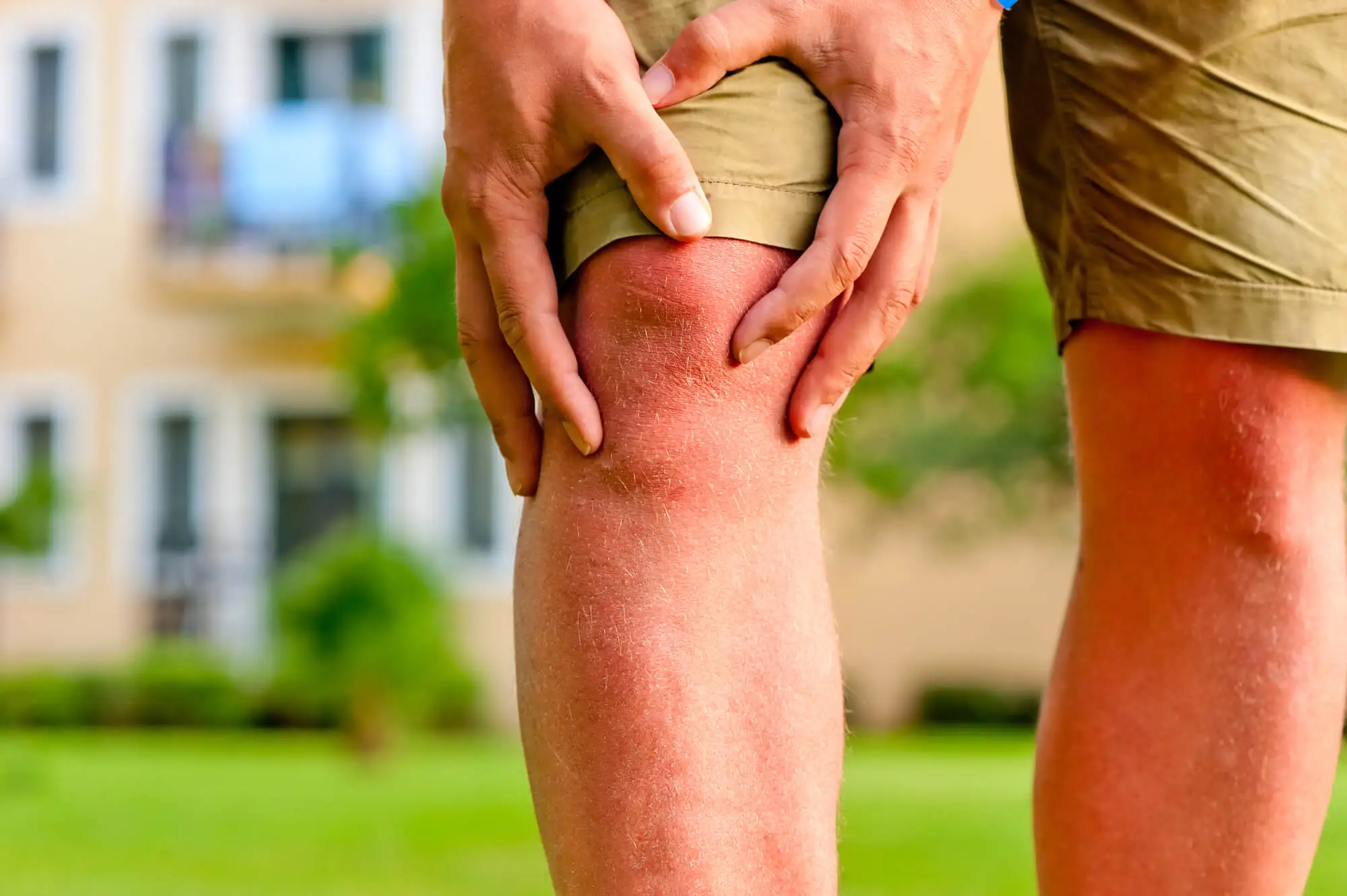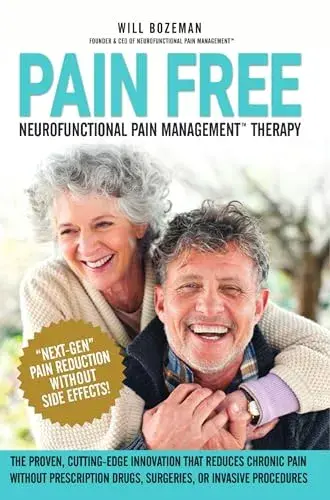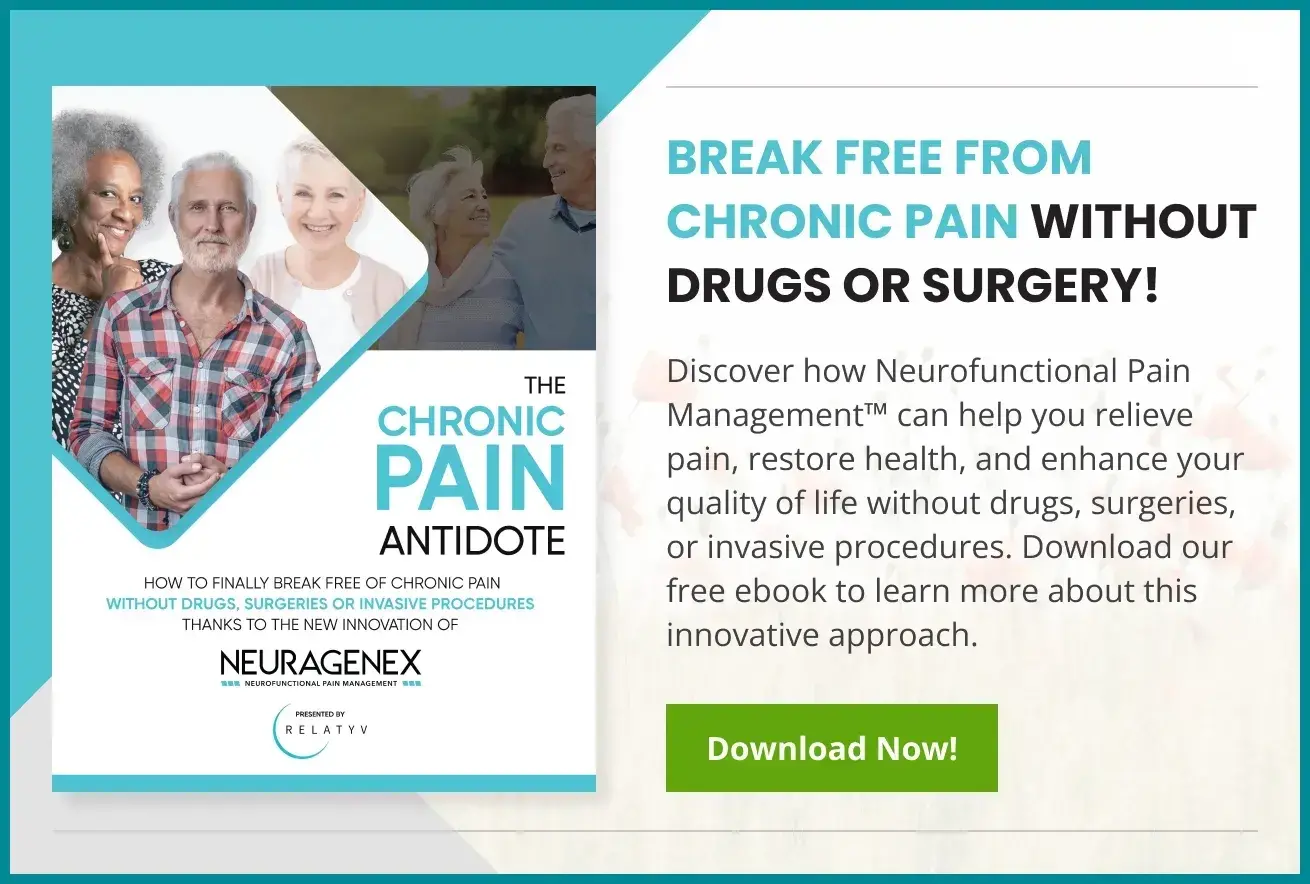Osteoarthritis

Osteoporosis Vs. Arthritis: What To Know About These Conditions
Read More
December 19, 2022
Osteoarthritis is a chronic pain condition and a pervasive medical problem across the world. It is often referred to as a wear and tear condition that continues to progress throughout a patient’s adult life until they are driven to seek treatment.
Osteoarthritis often presents in knees, fingers, and toes, but most joints are capable of developing osteoarthritis. Patients who suffer from OA can expect to experience chronic pain and inflammation that gets worse over time.
To make things worse, if you have been diagnosed with osteoarthritis, your physician or doctor may have recommended painkillers, steroids, or invasive procedures to ease the pain.
Fortunately, taking pain relievers every day or living in fear of having to undergo surgery are no longer the two alternatives available to treat the symptoms of osteoarthritis and improve your joints’ function.
In this guide, you’ll learn what we know – and what we don’t know – about osteoarthritis, and explore the treatment options that can help you magnify your quality of life. Let’s get started.
Osteoarthritis is one of the most common musculoskeletal conditions and a leading cause of disability in the elderly.
In a study conducted in 2021, Dr. Jeffrey Katz and his associates conclude that OA is, “. . . the most common joint disease, affecting an estimated more than 240 million people worldwide, including an estimated more than 32 million in the US. Osteoarthritis is the most frequent reason for activity limitation in adults” (2021).
While patients experience limitations from joint-damaging conditions such as OA, they should not discount that their pain and inability to operate their life normally could also result from multiple other chronic pain conditions.
Dr. Katz explains why patients may confuse OA with other conditions, such as neuropathy when assessing their symptoms by explaining that OA “. . . can involve almost any joint but typically affects the hands, knees, hips, and feet”. Patients should be careful and thorough in the assessment of their pain and understand its origin to properly target it for treatment.
This task is sometimes proven more difficult by the shared pain conditions themselves which, as Dr. Katz states to include, “. . . joint dysfunction, pain, stiffness, functional limitation, and loss of valued activities, such as walking for exercise and dancing”. With so many similarities that create a barrier to self-diagnosis, patients may wonder what the major differences could be.
The overlapping symptoms, as well as the fact that there is no definitive diagnostic test for osteoarthritis, cause people to wait nearly 8 years to receive an accurate diagnosis. At the same time, understanding the nature of your condition is the first step to accepting it and finding an adequate treatment option.
Let’s start by looking at the causes, symptoms, and risk factors for osteoarthritis.
Osteoarthritis is one of the most common forms of arthritis; an inflammatory disease that affects the joints.
Also known as “wear and tear” arthritis, osteoarthritis develops when the cartilage in the joints starts to break down. The cartilage is a soft, cushioning material located between a joint’s components, and has the role of protecting the bones from friction and shock damage during movement.
In people with osteoarthritis, the loss of cartilage is caused by the high levels of inflammation sustained by an overactive immune system. The high inflammation, coupled with the natural wear and tear of the cartilage that occurs as we age, can cause severe joint damage.
As the cartilage breaks down, the bones are left to rub against each other during movement, which can lead to a wide range of complications. For example, you may compensate for the pain you experience in one side of the joint by overloading another area, which can cause abnormalities and posture problems.
Additionally, if left untreated, osteoarthritis can cause chronic joint pain, inhibited range of motion, and disability.
Although there is no trigger cause of osteoarthritis, some factors can put some individuals at greater risk of developing this condition. Let’s look at the symptoms and risk factors of OA below.
Most of the symptoms of osteoarthritis are related to the progressive breakdown of the joint’s cartilage.
Most often, OA affects load-bearing joints such as the knee and hips. However, no joint is immune to this disease. For example, statistics by the Arthritis Foundation show that around 50% of women and 25% of men may suffer from hand osteoarthritis to some extent by the time they are 85.
Depending on what joints are affected by OA, you’ll experience the symptoms below around one or more areas of the body.
This is because high-impact, strenuous, or repetitive movements add unnecessary pressure to the joints, which are unable to endure such stress due to the loss of cartilage.
However, if the cartilage is severely damaged, the joint’s bones may not be able to move as they should, which can cause permanent mobility issues.
As we have seen above, there is no single cause that triggers osteoarthritis. However, some factors can put you at greater risk of developing OA. Learning about them is the first step to modifying your lifestyle and reducing the risk of suffering from this degenerative disease.
Here are some critical risk factors for OA and what you can do to reduce the risk:
Practicing regular physical activity can help you keep your muscles strong, prevent the age-related loss of muscle mass, and lower the risk of OA.
Occupational activities that require repetitive hand movements, such as typing on a keyboard, can increase the risk of hand OA. Working with an occupational therapist can help you understand how to practice your favorite activities without increasing the risk of suffering from degenerative diseases of the joints.
According to the Global Burden of Disease Study 2019, the prevalence of OA has grown by more than 113% between 1990 and 2019. Additionally, as life expectancy, global population, and rates of obesity continue to rise, OA is expected to remain one of the greatest health concerns worldwide.
The steady growth in the number of cases has contributed to a steady and persistent level of research into a treatment for the condition and this should be a welcome relief for anyone seeking said treatment.
Unfortunately, research from several in the medical community concludes that effective treatment for osteoarthritis is elusive and often lacks the efficacy desired by both patients and their doctors.
While a definitive cure for OA is yet to be found, there are several pain management strategies that you can use to ease the discomfort deriving from osteoarthritis. Below, we’ll look at the surgical and non-surgical alternatives often recommended by physicians.
Osteoarthritis is the leading cause of invasive surgical procedures such as knee and hip arthroplasty, or joint replacement surgery.
These procedures are prescribed to patients with advanced osteoarthritis, which has caused a severe loss of cartilage, bone spurs, or changes in the joint’s mechanics. Arthroplasty is an invasive surgical intervention that aims to replace parts of the joint that have been damaged with artificial components, usually made of metal or plastic.
It is important to note that these surgical procedures don’t cure osteoarthritis, nor are they able to stop the future degeneration of cartilage. Additionally, they involve 3-6 months of immobilization and rehabilitation, lead to several days of work lost, and, in some cases, require additional surgical interventions to achieve desired results.
As seen above, surgical interventions may help patients with severe osteoarthritis. But is surgery your only option? Other pain management methods are available, but they are not always effective. And, they are certainly not curative or disease-modifying.
With the need for effective nonsurgical treatment of osteoarthritis being sought by patients, even professionals in the medical community like Professor Brandt are frustrated with the lack of effective options available to their patients.
Professor Brandt, after surveying the available options, their limited benefits, and many side-effects, states that “. . . we surely need better and safer drugs to treat OA symptoms” (2004). The last thing patients of OA want to hear is that the symptoms they are attempting to treat with better and safer drugs are met with sometimes worsening side effects.
Throughout the survey of treatments, Professor Brandt also concludes that some drugs had little to no effect in a clinical trial when compared to the effects of a placebo.
It is perhaps most disconcerting to hear this statement which sums up the entirety of Professor Brandt’s concern: “Despite enormous increases in our understanding of pain mechanisms and of the metabolism, biochemistry, and molecular biology of articular cartilage . . . our track record for the development of more efficacious drug treatment for OA is discouraging”.
This is not to say that treatments do not exist for osteoarthritis; in fact, there are several. The issue, that Professor Brandt brings succinctly to the forefront, is the issue of efficacy.
Some of the most common conservative treatment options for osteoarthritis include the following:
However, more studies are needed to determine the efficacy of this treatment, and the American College of Rheumatology recommends against the use of these supplements in the treatment of hip, knee, and hand arthritis.
While this treatment may help relieve the pain during flare-ups, taking medications daily cannot be considered a long-term solution. Additionally, pain medications come with severe side effects, including the increased risk of stroke and heart attack, stomach ulcers, and dependency.
Patients may feel disheartened and hope for a simple cure that might end OA once and for all. Unfortunately, as is the case for many conditions, there is no cure for osteoarthritis. There are only treatments for the condition that can help manage the pain and improve limb functionality.
Dr. J.L. Whitaker and his associates cooperated with him in a 2021 study that evaluates our understanding of treating OA.
In the article, they state: “Given there is no cure for OA disease, and we only can offer persons who have OA illness modestly effective symptomatic treatments, the concept of prevention is attractive” (2021).
Many patients reading this would not accept that answer and conclude that they would have to go back in time to prevent an incurable condition from ever happening in the first place.
Nonetheless, with the right treatment options, it is possible for patients to improve the functionality of the joints affected by osteoarthritis, while also preventing the disease from progressing. Let’s look at what you can do to prevent and manage OA below.
Dr. Whitaker continues to explain that, “[t]he field of OA prevention is relatively young. To date, most of what is known about preventing OA and risk factors for OA is relative to the disease of OA, with few studies considering risk factors for the illness of OA”.
While patients assess their risk factors, including age and obesity, they may be able to determine their likelihood of worsening their already diagnosed condition. Patients may protest that age is a risk factor that cannot be mitigated, however, there are risk factors, including weight and diet, that can be addressed to mitigate the worsening of OA.
Dr. Whitaker explains this further and offers another manageable risk factor by concluding that “. . . as our understanding of disease mechanisms grows, it is important to acknowledge that OA may emerge as a heterogeneous disease that culminates in a common illness. Despite these important knowledge gaps, obesity and joint injury have emerged as strong and highly prevalent modifiable risk factors for OA disease and aspects of OA illness.”
While the best way to avoid worsening effects of OA is to mitigate the manageable risk factors, there are other treatment options that can help get patients into a better situation regarding their OA pain and improve joint flexibility.
Neurofunctional Pain Management offers a possible option for osteoarthritis pain relief by first addressing the pain relief with high pulse electrical stimulation, then addressing the health of the patient with specialized hydration therapy to enhance the effect of pain relief.
This combination of therapy creates an enduring pain relief effect and restores health so that patients are motivated and have a more positive outlook on their chronic pain condition, which magnifies their quality of life.
This is the core protocol of Neurofunctional Pain Management. With a new positive outlook on their situation, patients are motivated to act and to take direction for a better state of health and ultimately keep their chronic pain under control.
Relatyv is pioneering the field of Neurofunctional Pain Management and is creating the core principles that may bring sustained pain relief and restored health to millions of patients across the nation. Osteoarthritis pain is one of these conditions that can be treated with Neurofunctional Pain Management.
The specific protocol of combining high-pulse electrical stimulation simultaneously with hydration therapy is called Neuralgesia and is a proprietary treatment program offered exclusively by Relatyv. These two treatment protocols work together to produce the enhanced pain relief that can endure for several months after a patient completes a course of treatment.
As seen above, osteoarthritis is not preventable or curable. But this should not condemn you to live with excruciating pain and limited joint mobility! Thanks to the customizable Neurofunctional Pain Management programs offered at Relatyv, you can improve your quality of life, regain your joint’s mobility, and ease your pain – without invasive procedures or medications.
Here are some of the main pillars of a Neurofunctional Pain Management plan:
The mission of Relatyv is to relieve pain, restore health, and magnify the quality of life without drugs, surgery, or invasive procedures. This is the optimal pattern for sustained long-term pain relief from chronic pain conditions.
The first step is to relieve pain so that patients can experience the relief they need to be motivated to take additional steps for their nutritional health and physical movement and exercise.
This immediate pain relief can really help them gain the motivation to get relief and move forward with their lives. Restored health through specialized hydration therapy and nutritional deficiency balancing. In addition to these two protocols, we have an education program that offers lifestyle counseling for ongoing health and wellness activities.
This approach to chronic pain makes our mission statement much stronger to relieve pain, restore health, and magnify the quality of life while operating as a non-pharmaceutical, non-surgical, non-invasive, and non-chiropractic pain management treatment program.
If you suffer from osteoarthritis, taking pain medications daily or living in fear of having to undergo a total knee replacement surgery can have a profound impact on all aspects of your life.
Fortunately, thanks to today’s advances in regenerative medicine, and the whole-person approach of Relatyv, you can take advantage of a non-surgical, non-pharmaceutical, and non-invasive Neurofunctional Pain Management designed around your unique needs.
About the Author
Will is a healthcare executive, innovator, entrepreneur, inventor, and writer with a wide range of experience in the medical field. Will has multiple degrees in a wide range of subjects that give depth to his capability as an entrepreneur and capacity to operate as an innovative healthcare executive.
Share on Social Media




You can see how this popup was set up in our step-by-step guide: https://wppopupmaker.com/guides/auto-opening-announcement-popups/
You can see how this popup was set up in our step-by-step guide: https://wppopupmaker.com/guides/auto-opening-announcement-popups/
Neurofunctional Pain Management Overview
Symptoms
Conditions Treated
Treatments
Articles by Category
Locations
Colorado
Wisconsin
Georgia
Hiram
Lawrenceville
Marietta
Powder Springs
Texas
Waco
Victoria
Illinois
Buffalo Grove
New Lenox
St. Charles
Arizona
Tucson
Waddell
Arlington
Avondale
Buckeye
Superior
Mesa
Palo Verde
Morristown
Tempe
Chandler
Anthem
Eloy
Florence
Fort McDowell
Phoenix
El Mirage
Coolidge
Gilbert
Arizona City
Casa Grande
Casa Blanca
Aguila
Sacaton
Apache Junction
Kearny
Stanfield
Goodyear
Litchfield Park
Alabama
Arkansas
California
Florida
Idaho
Indiana
Iowa
Kansas
Louisiana
Maryland
Michigan
Rhode Island
Minnesota
Mississippi
Nevada
New Jersey
New Mexico
North Carolina
Ohio
Pennsylvania
South Dakota
Tennessee
Utah
Virginia
Washington

